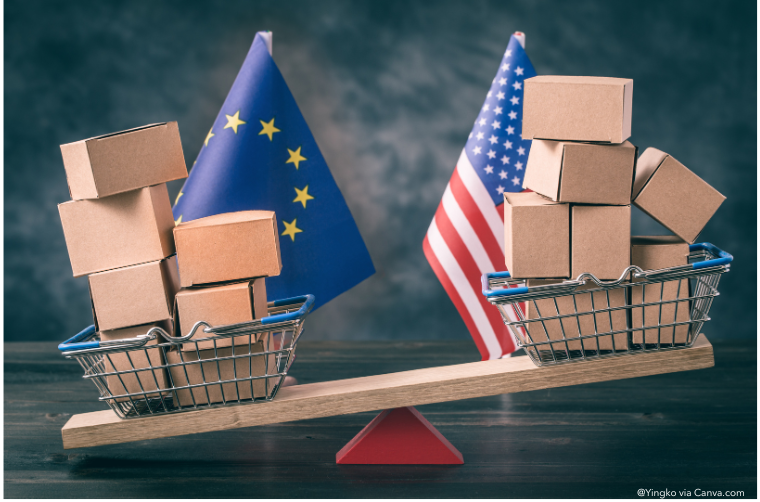
Since returning to the White House last January, United States President Donald Trump has multiplied attacks on trading partners, including the European Union, starting with a global 25% tariff on steel and aluminium, which took effect on 12 March. Going further, in March the US administration announced a 25% tariff on cars and car parts, and on 2 April, 20% duties on European exports. However, under strong pressure from fluctuating markets, both the 20% tariff on EU exports and the Union’s countermeasures to the steel and aluminium tariffs are currently on pause. Indeed, Donald Trump agreed on 9 April to introduce a 90-day suspension of the global tariffs, including the 20% duties on EU exports, which supposedly responded to a 39% EU tax rate on US goods and aimed at lowering the US’s global trade deficit.
Meanwhile, mirroring the US position, European Commission President Ursula von der Leyen announced on 10 April a similar 90-day pause in the EU’s countermeasures, in line with the statement announcing them, which indicated that the countermeasures could be suspended at any time if a negotiated solution were found instead. The European Commission had indeed previously expressed a positive view of EU-US trade relations, pointing out the complementarity of both economies. According to the EU executive, when considering both goods and services, the EU registered only a 3% trade surplus with the US in 2023. Additionally, the average tariff rate on both sides was just 1%. That same year, the US collected about €7 billion in tariffs on EU exports, while the EU collected around €3 billion on US exports, despite total EU-US trade reaching €1.6 trillion. Still, far from fully backtracking, the US administration has notably threatened further tariffs on pharmaceuticals, and the bloc remains subject to the 10% base rate that took effect on 5 April.
Currently, the EU is still crafting its response, on the one hand preparing for escalation and the rollout of countermeasures, and on the other seeking to negotiate with Donald Trump. In a relative show of European unity, all member states, except Hungary, agreed to the retaliatory package, voting in favour of targeting nearly €21 billion of US products, from soybeans and motorcycles to orange juice, almonds, and yachts, in response to the initial steel and aluminium tariffs. Duties had initially been set to be collected progressively from 15 April. Meanwhile, the EU has still offered the United States a “zero-for-zero” tariff scheme, targeting industrial goods such as cars, chemicals, pharmaceuticals, rubber, and plastic machinery. Put forward again after the 90-day suspension, the offer was first dismissed by the US executive on Monday 7 April, with Donald Trump instead asking the EU to commit to buying $350 billion worth of American energy.
While the EU has steadily increased its American LNG purchases, particularly since divesting from Russian fossil fuels, and is open to expanding trade with the US, it remains unlikely that the bloc would consider depending so heavily on a single country. In addition, Trump has also called on the Union to lower its standards and safety measures to allow more US products into the single market, but the EU’s willingness to do so remains to be seen.